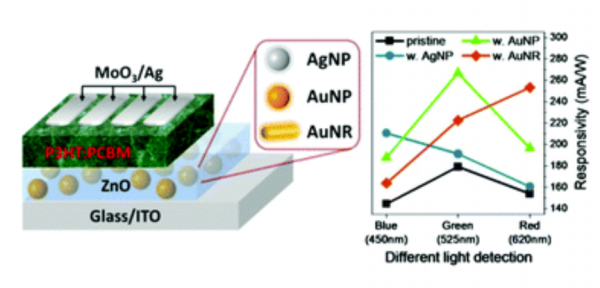Plasmon-mediated wavelength-selective enhanced photoresponse in polymer photodetectors
- 저자
- Huan Wang*, Ju Won Lim, Filipe Marques Mota, Yu Jin Jang, Minji Yoon, Heejun Kim, Wei Hu, Yong-Young Noh*, Dong Ha Kim*
- 저널명
- Journal of Materials Chemistry C, 5, 399-407 (2017)
- 년도
- 2017
- Link
- https://doi.org/10.1039/C6TC04662B 152회 연결
[Abstract]
Photodetectors have gained increasing interest in both academic and industrial domains in a ranging number of applications, including image sensing, communications, environmental monitoring and chemical/biological detection. Noble metal nanoparticles exhibit surface plasmons (SPs) associated with the enhancement of a local electromagnetic field surrounding the metal surface, leading to enhanced light absorption. Herein, size-controlled silver nanoparticles (AgNPs), gold nanoparticles (AuNPs) and gold nanorods (AuNRs) have been introduced into polymer photodiodes. The evaluated devices exhibit remarkable photocurrent enhancement at corresponding plasmon resonant wavelengths, directly resulting in a photosensitivity increase. When compared with a pristine photodiode, AgNPs-, AuNPs- and AuNRs-mediated devices reveal maximum enhancements of 46, 49 and 65% for responsivity and 39, 30 and 54% for detectivity for blue (450 nm), green (525 nm) and red (620 nm) light detection, respectively. The linear dynamic range of plasmon-mediated devices and their photoresponse stability have been further explored. The mechanism of plasmon-enhanced photocurrent has been analyzed using steady-state and time-resolved fluorescence measurements. The results indicate that plasmonic structures incorporated into polymer photodetectors can significantly improve the photoresponse in their plasmon resonant regions. This contribution is believed to showcase the effectiveness and attainable wavelength-selectable photodetection by tailoring the size and shape of coupled plasmonic nanostructures.
